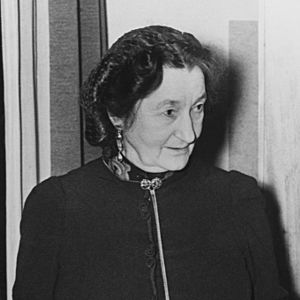Emilie Demant Hatt facts for kids
Quick facts for kids
Emilie Demant Hatt
|
|
|---|---|

Emilie Demant Hatt in 1940 at a Nordiska museet event.
|
|
| Born | January 21, 1873 Selde, in northern Jutland, Denmark |
| Died | December 4, 1958 (aged 85) |
| Occupation | Painter, writer, ethnographer |
| Notable works | "With the Lapps in the High Mountains" |
Emilie Demant Hatt (born Emilie Demant Hansen) was a talented Danish artist, writer, and ethnographer. She was born on January 21, 1873, and passed away on December 4, 1958. She was especially interested in the culture and way of life of the Sámi people, who live in northern Europe.
Contents
Emilie's Early Life and Studies
Emilie Demant Hansen was born in 1873 in Selde, a town in northern Jutland, Denmark. Her family owned a business. When she was a teenager, she had a close friendship with the famous composer Carl Nielsen. She even kept some of his early music writings safe.
From 1898 to 1906, Emilie studied painting and drawing in Copenhagen. She attended the Women's Academy of Art, which was part of the Royal Danish Academy of Fine Arts. During her studies, she changed her last name to Demant.
Discovering the Sami Culture
In 1904, Emilie and her sister took a train trip to northern Scandinavia. On this journey, they met a Sami wolf hunter named Johan Turi. This meeting changed Emilie's life! She became very interested in Sami culture and their way of living.
Johan Turi told Emilie he wanted to write a book about the Sami people. Emilie, in turn, said she had always wanted to live like a nomad. To understand the Sami better, Emilie spent several years learning the Northern Sami language at the University of Copenhagen. She continued her art studies at the same time.
Emilie's Amazing Career
In 1907, Emilie went back to northern Scandinavia. She lived with a Sami family, Sari and Aslak Turi (Johan Turi's brother), in the Swedish mountains. She traveled with them and other Sami people during the winter and spring of 1907 and 1908. She even spent the summer of 1908 in Tromsdalen.
Even though she wasn't officially trained as an ethnographer (someone who studies cultures), Emilie kept a detailed journal. She took many photographs and drew sketches of everything she saw. She was the first woman to live so closely with the Sámi people to study their lives. She also discovered some unique Sami cultural practices, like how mothers shaped their babies' heads.
Helping Write a Book About the Sami
In the fall of 1908, Emilie spent about two months with Johan Turi in a mountain cabin. She helped him write his book, Muitalus sámiid birra, which means "The Book of Lapps." She took his handwritten notes in Sami back to Denmark.
Emilie then carefully copied the text, translated it into Danish, and organized it. The book was published in 1910 in both Sami and Danish. Later, in 1931, an English version called Johan Turi’s Book of Lapland was released.
More Travels and Writings
Emilie made another trip to Sweden in 1910. She lived with a South Sami couple, Marta and Nils Nilsson. In 1913, she published her own book, Med lapperne i højfjeldet, which means "With the Lapps in the High Mountains." This book shared her experiences and observations of Sami customs from her year of nomadic travels.
Emilie Demant Hatt continued to paint throughout her life and showed her artwork in exhibitions. She wrote more books about the Sami people and created many paintings focused on Lapland. Many of her paintings are now kept at Stockholm's Nordic Museum. Other works can be found at the Skive Museum of Art. She also collected a large number of Sami costumes, which are now part of the National Museum of Denmark.
Awards and Recognition
Emilie received several awards for her important work. In 1915, she was given the Barnard Medal Award. In 1940, she received the Arthur Hazelius medal in Stockholm for her research on the Sami people. She was also a member of the Geographical Society of Finland.
An American translator, Barbara Sjoholm, has done a lot of research on Emilie Demant Hatt's life. She has translated two of Emilie's books into English. Barbara Sjoholm also wrote a biography about Emilie in 2017 called Black Fox: A Life of Emilie Demant Hatt, Artist and Ethnographer.
Emilie's Personal Life
Emilie had a close friendship with Hjalmar Lundbohm, a Swedish geologist and chemist, whom she met in 1907. Her artist friends included Christine Swane and Olga Lau, who studied with her.
In September 1911, Emilie married Aage Gudmund Hatt. He was a professor of cultural geography at the University of Copenhagen.
Emilie Demant Hatt wrote her autobiography, Foraarsbølger ("Spring Torrents"), in 1949. After she passed away in 1958, the book was given to the Royal Danish Library. It was kept secret for 25 years and then forgotten until 2002, when it was rediscovered and finally published.

